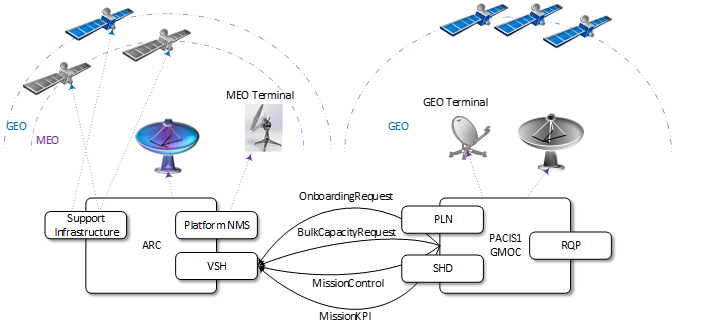
-
StatusCompleted
-
Status date2025-01-22
-
Activity Code7A.067
The final product of the MEO Extension to REACH project is designed to provide an extension of the Precursor PACIS-1 (now named REACH) project to support MEO mPOWER capacity in addition to the existing GEO capacity.
The objective was to develop an interface to REACH that enables the users with the option of booking mission requests using the SES MEO mPOWER constellation and/or GEO constellation.
The implementation of MEO Extension to REACH requires the integration between the GMOC, which is the platform in charge of the booking, assignment, distribution and administration of the services and satellite capacity offered by REACH. The ARC oversees the booking, assignment, distribution and administration of services and satellite capacity of SES' MEO mPOWER Platform.
This integration includes the preparation of the ground stations to support MEO and GEO constellations according to the customer requirements, and the improvement/enhancement of the GMOC platform. Therefore, the service is operated with MEO antennas and GEO antennas, as well as satellite modems capable of supporting both constellations.
The project expands the possibilities of coverage of the service by increasing the number of satellites available in the REACH platform.
By including the SES mPOWER MEO fleets, the user has higher throughput, expanding the range of services that can be carried through satellite communications.
The system decides whether to use MEO or GEO constellations depending on customer requirements such as throughput location, delay, jitter, optimising the resources and assuring the service delivery to the customers.
The customer will have the possibility of switch from MEO to GEO and from GEO to MEO with the same satellite modem, giving versatility to the service in terms of throughput, location, type of service and SLA.
- Possibility of requesting Services on GEO or MEO in a single platform/ user interface.
- MEO and GEO Services with a Single Modem.
- Low latency for critical mission applications
- Data rate up to 300 Mbps RTN and 1.5 Gbps FWD.
- Global coverage of services.
- Intelligent service, defined by location, throughput, constellation, or type of traffic.
MEO extension to REACH will be using the SES mPOWER satellite fleet and services for the user cases that involve MEO orbits, and the REACH GEO platform for the user cases that involve MEO and GEO orbits.
SES mPOWER provides the services end to end over the MEO orbits, which means that REACH will manage the service through the Unified API, which links the REACH GMOP to the mPOWER Ecosystem (OSO, SRI, CRM and ARC), and will use the mPOWER satellite HUB baseband and remote site solutions.

- Requirements Review (RR): Release the updated technical requirements specification.
- Preliminary Design Review (PDR): Approve the technical requirements specification at all levels, verify the preliminary design of the selected concept and technical solutions against all requirements (including interfaces).
- Critical Design Review (CDR): Approve the final design, assess, through review, analysis or test results, the compliance status with the technical requirements specification (including interfaces).
- Test Readiness Review (TRR): Verify test documentation availability and suitability, verify that the tested item(s) is(are) built to the required standard, check that the item is in the correct test configuration.
- Factory / On-Site Acceptance Test (FAT/SAT): Review outcomes of the verification performed internally by contractor, perform a subset of verification tests witnessed by ESA, verify the acceptability of any non-conformances.
- Final Review (FR): Present a summary of the outcome of the development, including conclusions and recommendations, propose an outline of future product development strategies, present the qualification test results (if no qualification review has been held previously), provide an estimation of the socioeconomic impact of the product development and of the subsequent commercialisation of the product.
The project is now completed.



